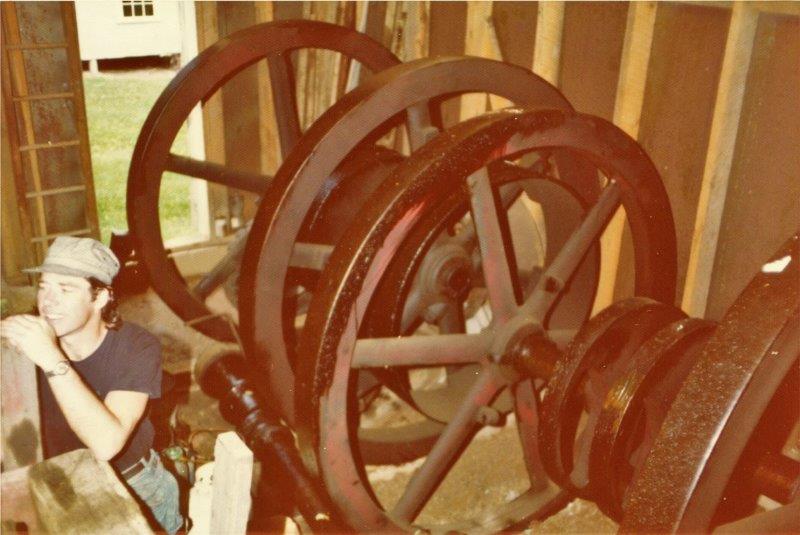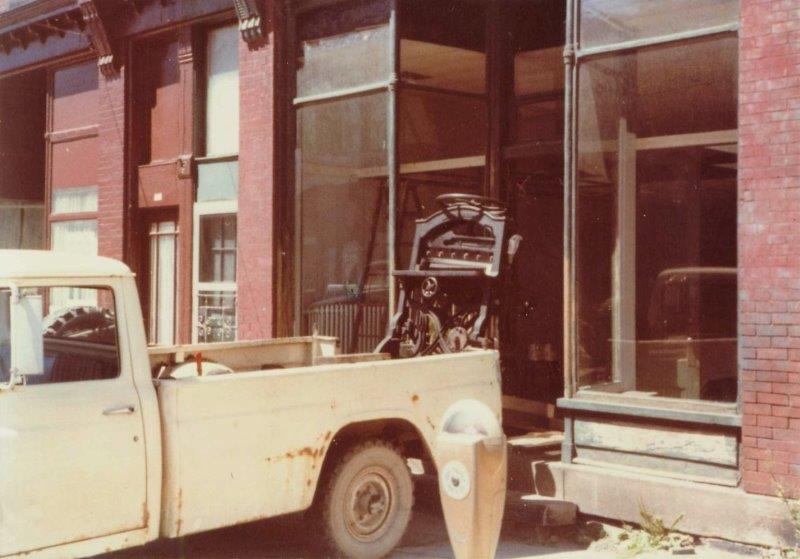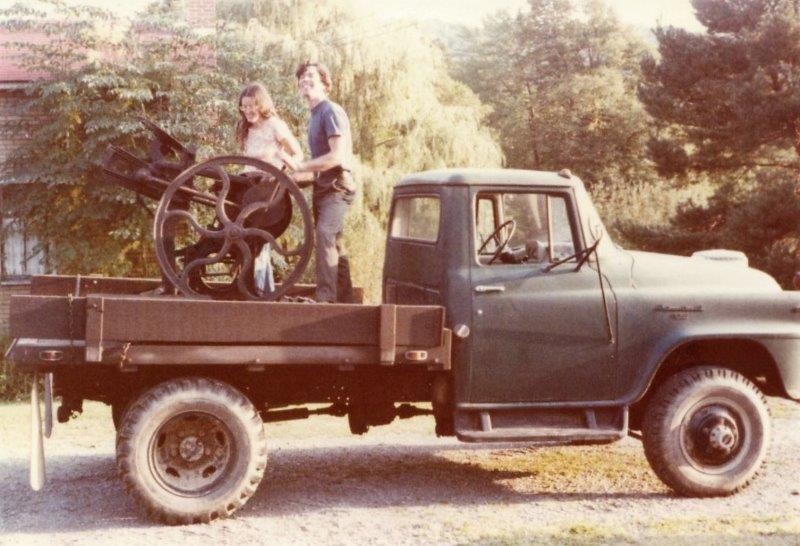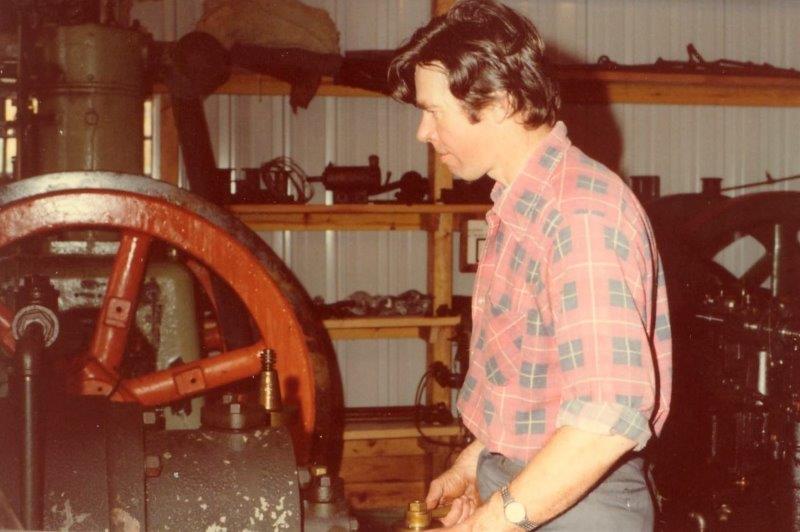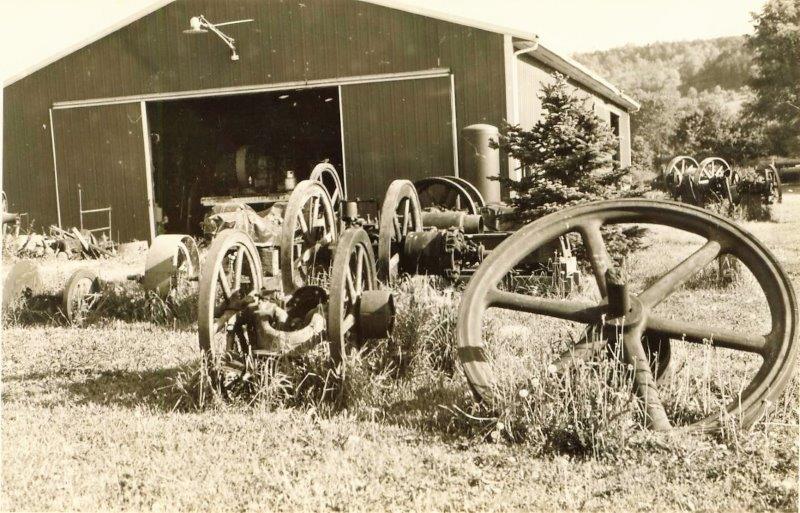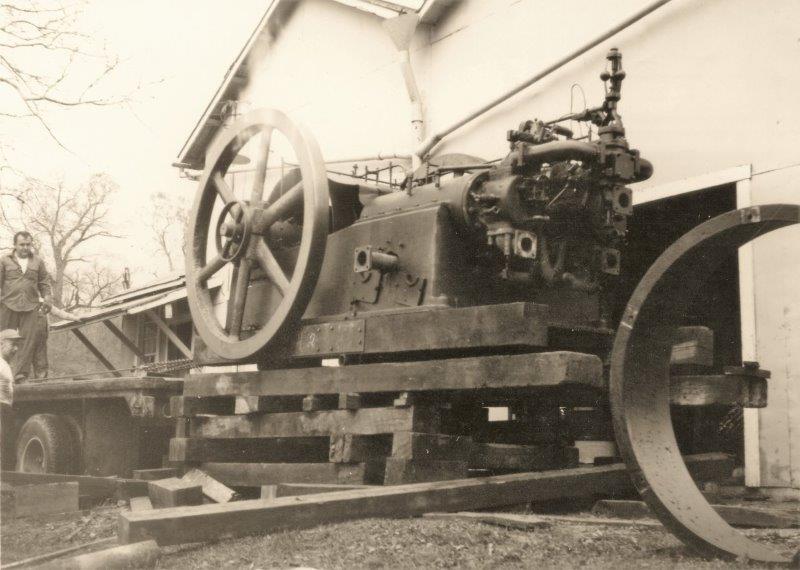|

September 2016
Memories
By Paul Harvey
This article about John Wilcox was made possible by Pat Wilcox, who loaned a portion of
John's photo collection to Clark Colby. Diligently, Clark
converted about 100 of the photos to digital media and shared them with me. Enjoying
all, I finally chose 20 photos to share with our readers for this
article. I had not seen the photos before, and they were all
unlabeled. However, I could recognize the identity of many of them.
I'm sure that almost all the black and white photos were
taken with John's trusty Brownie camera. He used it for many years.
Several of the color images were taken by me and given to John. I do
not know who took the others. The photos probably range from the mid
1960s to the mid 1990s. I hope the reader enjoys this jaunt down
memory lane and appreciates some glimpses of the past. And so, the
adventure starts!
Photo 1 shows a smiling John Wilcox posed with
two sets of well-greased flywheels in his big building at Trail Run. He
is in his normal work attire of jeans, black tee shirt and cap. Trail
Run, located in eastern Ohio,
was the old Buckeye Pipe Line Company's station that John purchased to
preserve. He built a large building there in the late 1960s to house
the many engines he was saving. Soon that building was full and the yard
housed many well-tarped engines. Trail Run included the original
station, the office building, as well as a large water cooling tank. He
hosted many pleasant "Flywheel Rolls" there in days gone by.
The Witte mine hoist and engine, now at the museum, was found
in the structure shown in Photo 2. It came from the west,
but no other information exists. Note the skiff of snow and the flat
land beyond. It apparently pulled an ore bucket from a mine. The
identity of the person in the photo is not known.
Photo 3 shows John's inverted Struthers Wells
engine at its original location. It pumped an oil well near the Kinzua
Dam and belonged to the legendary oil producer, J.L. Billstone of
Warren, Pennsylvania. He was famous
for patching things together to keep them running. J.L. also had some
very unusual engines pumping wells including the Struthers Wells, an
Otto that he called the Philadelphia
engine, a Fairchilds Betts, and a disc crank
Bessemer half breed. You can see the chain
around the cylinder on the Struthers Wells, used to hold the pieces
together! Note, this engine is not the one on display at the Museum.
Perhaps John's last big, single-handed, rigging job was
saving this huge Miehle newspaper printing press. It was an immense job
to get it out of the building and up timbers onto the truck bed. See
Photo 4. John bought the 1957 Dodge truck in 1990 from
Clark Colby and Clark's dad. This truck, with a 354 cubic inch A
series hemi engine, was able to haul heavier loads than his
faithful 1952 International could handle. John displayed the press at his later
home in Delaware,
Ohio.
Photo 5 jumps to 1994, when the museum removed
the huge, 400 hp Busch-Sulzer air injection diesel engine from the
Greenport, New York,
municipal light plant. John is in mid-center of the photo and smiling as the week-long job nears completion.
The engine is being winched onto the trailer by Gene
Shepherd's huge chain drive, F model Mack. Soon it would be in
Coolspring. This part weighed 40 tons.
In the early 1980s, we heard rumors of a large engine in the
basement of an old mill in St. Mary's,
Pennsylvania. After some searching, we found the
Climax engine
in the basement of the Widman Drug Store, which originally had been a
mill. Note Photo 6. The only access to the engine was
through a trapdoor and ladder. The ladder is seen in the left of the
photo. It was hibernating for so many years with all the cobwebs and a sea of line
shafting. Only after the building changed hands
were we permitted to make a large hole in the floor and remove the
engine piece by piece.
John always had a love for printing equipment and, in the mid
1980s, he learned that the old "Punxsutawney News" was closing its
doors. Although the shop once printed the newspaper, the elderly gent
running the place at the time, a Mr. Miller, was then
only printing funeral cards. Photo 7 shows loading an
ancient paper cutter onto my 1965 International pickup truck. John
obtained many fine items from the shop.
Photo 8 depicts a happy John and Pat standing
on his B140 International truck. They are smiling at an early platen
type printing press obtained from the Punxsutawney News. This was
probably the last item that Mr. Miller used. All the items were in very
good condition.
This undated black and white image, Photo 9,
shows John standing behind his beloved 15 hp Otto. It was taken in the
Power House of the museum many years ago. This engine and its twin
powered the water pumping plant at the Roebling country estate in
Pickpay, New Jersey.
Built entirely to the Roeblings' request, it featured special heavy,
electric lighting flywheels and a glass fuel overflow bulb. It is still
at the museum in what is now known as the John P. Wilcox Power House, and
it runs superbly.
Another unmarked picture, Photo 10, is a
very complete, 10 x 18 Model 4 Klein loaded on John's 1952
International truck. This would be a five-ton load for a two-ton
truck - not an unusual situation for John! John was very
instrumental in saving so many of these fine engines in the 1960s. At
that time, both Buckeye Pipe Line Company of Ohio
and the Eureka Pipe Line Company of West Virginia
were either closing the stations or updating. Without his efforts,
these engines might only be memories.
Photo 11 is a 1970s picture of the museum's 300 hp Miller
engine in Spring Creek Station. It was still in daily service. Note
the belt over the flywheel, and all the metal shields. Its engineer,
Manley Irons of Kane, Pennsylvania, kept the engine running despite its many
problems. It operated a huge Ingersoll-Rand air compressor to pump oil
wells; the most distant well was eleven miles away! Finally a
compressor failure caused the rig to shut down, and it came to the
museum in 1976.
A very nice 12 x 24 Model 1 Klein engine is seen in Photo 12.
The photo is not labeled, but it appears to be in its original
location. Only three of these magnificent engines still exist. Does
anyone recognize this engine?
John brought the first English engine to the museum in the mid-1970s
Dennis McCormick imported two National engines and sold one to John.
They had operated a water pumping plant in
England and were fresh out of service.
In Photo 13, we see John adjusting the controls on his
engine. Only the top of the National is seen in front of John on this
old photo.
The Big Barn, as it was called then, was erected in 1971 and soon
became the location of the growing collection. Note Photo 14.
In those days many engines were becoming available and I was
hauling home one engine a week in addition to working a full-time job. So after the building
was full, the outside yard served as the collection area. If you notice
closely, there is even an engine still loaded on the tilt bed truck.
It appears in the doorway. But back then, the price was right and
we had to get the machines before the scrap dealer did. The structure is now named the
Power Technology
Building.
Photo 15 shows one of the two existing 90 hp twin Kleins
as it was being removed from Joy Station in Ohio.
This probably was in the mid 1960s. They are both in collections and
run again. The identity of the person in the photo is not known.
A small, single flywheel engine was found in John's old pictures, see
Photo 16. There is no identity and I never saw the engine.
It has a side shaft and a Schebler carburetor. It looks very
interesting; any ideas on what it is or where it could be?
Photo 17 is a picture of John on top of an engine during
the night. John and I frequently continued exploring long after nightfall, and with his flashlight he had to see everything. I was content
to stand on the ground and explore from there. The engine is noted to
be a Worthington diesel, and
the building appearing to be very large. My guess is that it's a station of the old
Tidewater Pipe Line Company located in eastern
Pennsylvania. The Tidewater pumped crude oil
from Rixford, Pennsylvania,
to a refinery in Marcus Hook, Pennsylvania. The original Tidewater used the Snow
diesels and pumped to the Susquehanna River; a
later extension used the Worthingtons and continued the entire way to
Marcus Hook.
Another little unknown is seen in Photo 18. The picture
is an old black and white and has is unidentified. Another photo
shows a set of five-spoke flywheels mounted on a crankshaft. I have no
idea; any thoughts?
Photo 19 is indeed a heavy load for this little truck.
Before John had his own truck, he would either rent one or borrow one
from a friend; whatever he could do to save another Klein. This engine
appears to be a 10 x 18 Model 3 Klein, weighing about five tons! The
pipeline station is not identified, but one can see the large oil tank.
Note the space under the front wheels of the truck, and the two huge
rope blocks used to manually pull in on. Now this is determination!
In conclusion, Photo 20 shows John on his Speedster.
Built by Dick Vincent of Gap, Pennsylvania, this unit was a modified American
LaFrance fire truck. With the huge "T" head, six-cylinder engine, and
overdrive sprockets to the rear wheels, its top speed was never tried.
Pat and her two daughters, Sandy to the left and Laura to the right, are
in the back seat. The apple tree is starting to blossom, and all looks
right in Coolspring - so many years ago. And so our adventure closes.
Next month I will share some photos of my August trip to
England. London
has some great engines and I think you will like them.
|

